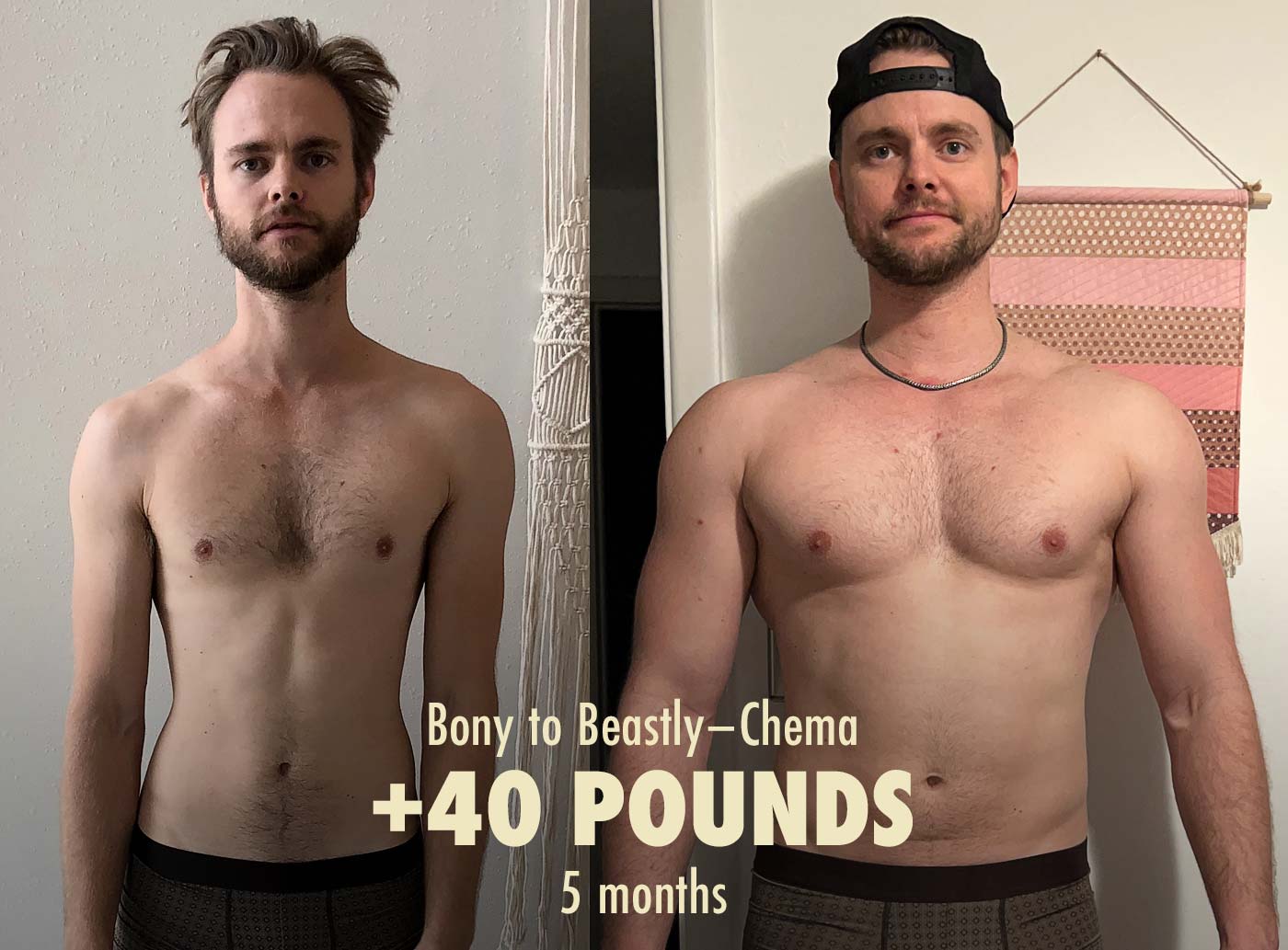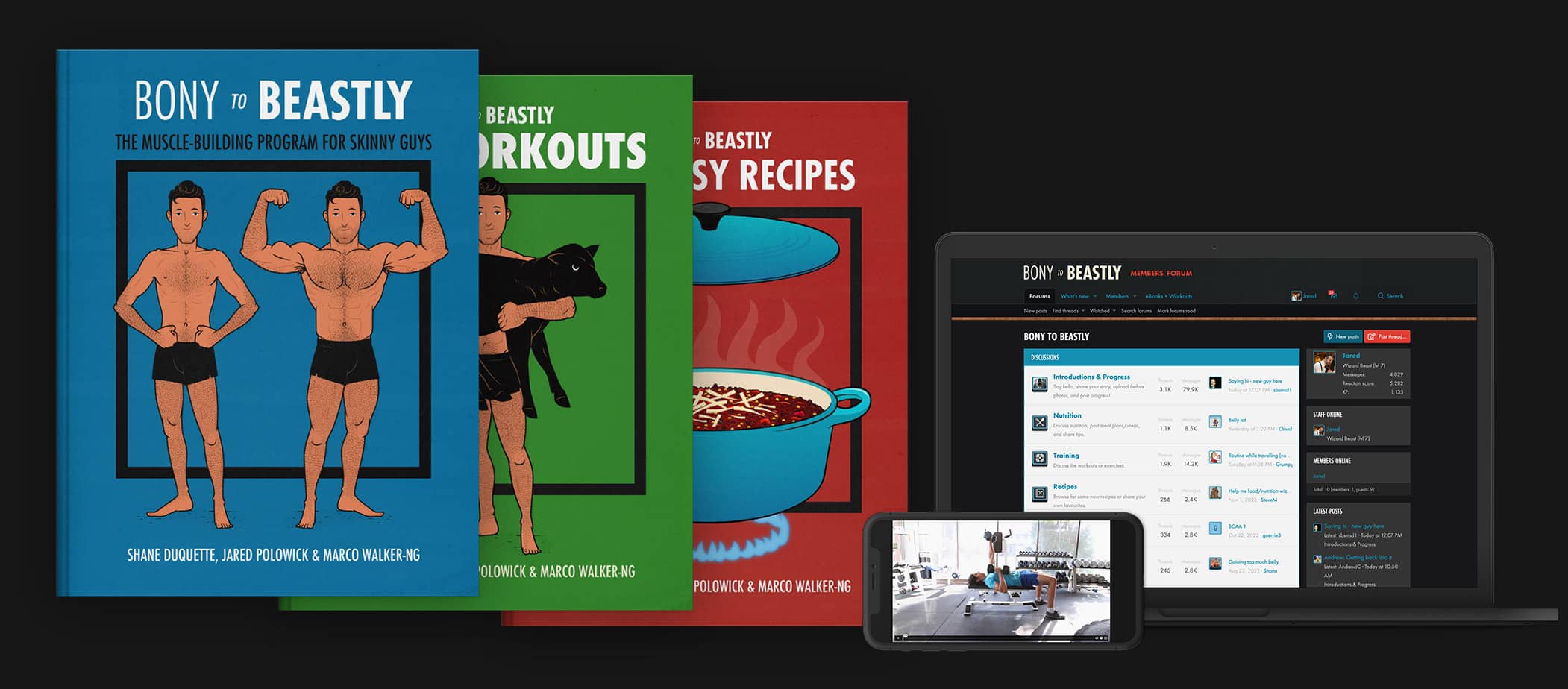Bulking Calorie Calculator
With Macronutrient Recommendations
How the Calculator Works
Most calorie calculators use your age, height, and sex to estimate your leanness and muscularity. I like using those calculators because I feel like they're really taking the time to get to know me. Unfortunately, they aren't as good at calculating your calorie needs.
For example, if you tell it that you're old, it will assume you have less muscle. That's true on average. But if you lift weights, then growing older allows you to accumulate more muscle mass. You'll be more muscular at 60 than you were at 20, not less so.
We've written about how age affects muscle growth here. The point is that instead of making assumptions about how lean and muscular you are, it's better to just ask.
That's why this calculator asks for your weight and body fat percentage instead of your age, height, and sex. It still isn't perfect, especially for skinny people, but we'll deal with that below.
Body-Fat Percentage
If you know your weight and have a rough idea of your body fat percentage, we can estimate how lean and muscular you are. This allows us to calculate your resting metabolic rate more accurately (using the Cunningham Equation).
- 10% body fat: chiselled abs.
- 12% body fat: faintly visible abs.
- 15% body fat: flat stomach, maybe some upper abs.
- 20% body fat: flat stomach, maybe some love handles.
- 30% body fat: you don't need to bulk.
Muscle-Building Mini-Course via Email
Sign up for our 5-part muscle-building mini-course that covers everything you need to know about:
- Hardgainer genetics and how to make the most of them.
- How to take a minimalist approach to building muscle while still getting great results.
- What you need to know about aesthetics, health and strength while muscling up.
Lifestyle & Activity Levels
Once we know how many calories you burn at rest, we can factor in how active you are (using an activity multiplier).
- Sedentary: You spend almost all day sitting. This is common with deskworkers, students, and people who write articles about how to bulk up.
- Somewhat active: You spend most of your day sitting, but you also spend an hour or two walking around. Maybe you have kids or a dog. Your daily step count might be 5,000–10,000.
- Very active: You spend most of the day on your feet. Think manual labourers, personal trainers, athletes, and nurses. Your daily step count is probably far north of 10,000.
Exercise (Workouts Per Week)
Any type of exercise counts as exercise, whether that's cardio or hypertrophy training. Cardio tends to burn the most calories, but a hearty bulking workout can still burn upwards of 300 calories per hour. We need to factor that in.
You can count any workout that's at least moderate intensity. Don't count warm-ups, stretching, yoga, or walking the dog. Do count weight training, brisk walking, jogging, rucking, cycling, and other forms of cardio. Playing sports counts, too.
If the workout is half an hour or less, only count it if it's more intense. For example, 15 minutes of high-intensity interval training (HIIT) would count as a workout, whereas going on a 30-minute walk every morning doesn't count. (That's part of an active lifestyle.)
Thickness
We've been using research-based formulas until now. This next part of the calculator is based on our experience using these bulking calculations with clients. The calculations were often ≈200 calories too low for our thinner clients and ≈100 calories too high for our thicker ones, so we're adding an adjustment factor.
You'll still need to weigh yourself every week and adjust your calories accordingly, but this should speed up that process by 1–2 weeks.
Rate of Weight Gain
Finally, we need to add the extra bulking calories. We've written about the ideal rate of weight gain here. Here's a quick summary:
- Lean bulking (+250 calories) is when you eat in a small calorie surplus to reduce your risk of gaining fat. Eating fewer calories is easier on your digestive system, but the margin of error is small, so you'll probably need to track your calories.
- Aggressive bulking (+500 calories) is when you eat in a large calorie surplus to maximize your rate of muscle growth. It's the fastest way to build muscle, and it works well for skinny or underweight beginners. I gained my first 40 pounds this way.
- Classic bulking (+750 calories) is based on what works best for the average person. Most experts recommend it. It's designed to help you steadily gain muscle without gaining a disproportionate amount of fat.
Macro Recommendations
The macro recommendations are the minimum amount of each macronutrient you need to maximize your rate of muscle growth. You should have some extra calories left over. You can spend those however you like.
For example, if you eat even more protein than the calculator recommends, you’ll still benefit from the calories and micronutrients, but the extra grams of protein won’t speed up your muscle growth.
The carbohydrate recommendation might seem aggressive, especially if you’re used to eating low-carb or ketogenic diets. Carbs can be incredibly nutritious and great for building muscle (as explained here), but you don’t need to lean so heavily into them. If you do, ease into it gradually. Give your body time to adjust.
A good rule of thumb is to eat at least 10 grams of fibre per thousand calories. For example, if you're bulking on 3,000 calories, aim for 30+ grams of fibre. If that seems like a lot, increase your fibre intake gradually to give your gut time to adapt.
If your calorie intake is very low, you might not be able to reach all of these minimum targets. If that happens, cut back on carbs. Protein is needed to build muscle and fat for proper hormone production. Carbs are the most expendable.
What If You Aren't Gaining Weight?
Naturally skinny people often resist weight gain. That’s why we’re skinny. We wrote about this in our hardgainer article. There are a few reasons why it's so hard:
- There's a genetic component to metabolism. You might burn quite a few more calories than the average person.
- Your metabolism might be adaptive. Some people burn more calories when they eat more calories.
- You might be underestimating how many calories you're eating. Nutrition labels aren't perfectly accurate. Calories can stick to the bottom of your pan. A little oil might get left on your plate.
The solution is as simple as it is cruel: you need to eat even more calories. Try adding another 200. I'm so sorry. If you find that as hard as I do, we have an article about how to eat more calories.
What if You Stop Gaining Weight?
All a calorie calculator can do is give you a reasonable starting point. You aren't supposed to stick with the recommendation forever, just for the first week or two.
Muscle burns around 6 calories per day at rest, and you also need to carry it around with you (study). That means you'll need to eat around 12 more calories for every pound of muscle you gain (explanation).
Your metabolism can also adapt (study). As you get used to eating more calories, your body might get used to burning more calories. It's sort of like how if you get a raise at work, you might start spending more money, cancelling out some of the extra savings.
Weigh yourself on the scale every week (or use a weekly average weight). If a week goes by and you haven’t gained weight, it might just be a fluctuation, so hold steady for another week. If your weight stays the same for a second week, add 200 calories to your diet.
Keep weighing yourself and adjusting. That's the only way to guarantee continued progress. It gets harder as you get deeper into your bulk, but it doesn't last forever.
A Calorie Surplus Isn't Forever
When I first started bulking, I was terrified my calorie needs would keep climbing higher and higher. I worried that to maintain my gains, I would need to overeat forever. Thankfully, that wasn’t true. I’m nearly 70 pounds heavier than when I started, and I enjoy my diet now more than ever.
When you finish bulking, you can do a Reverse Bulk. I've never heard anyone else talking about this, but it's surprisingly effective. We use it with clients all the time.
To do a reverse bulk, keep working out, eating a good diet, and living a healthy lifestyle, but start listening to your appetite again, eating only as much as you want. You’ll lose some fat, your metabolism will slow back down, and you’ll be back to eating an intuitive, comfortable amount of food.
Another option is to cut, intentionally eating in a calorie deficit to burn fat faster. We have a cutting guide and a cutting calorie calculator.
If you want to know how big you should bulk, I made another calculator that estimates your ideal body weight and muscle measurements. You don't need to get there in your first bulk, but it's nice to have realistic longterm goals to aim for.
SHould You Track Your Calories?
You don't need to track your calories to bulk up. I gained my first 40 pounds by eating similarly sized meals at similar times every day. When my weight gain stalled, I'd make those meals a little bigger, have it with a side of milk, or add an extra snack. (More on that here.)
After that, I tried tracking my calories while cutting, and I'm so glad I did. I learned a tremendous amount about my specific eating habits and about nutrition in general. It gave me a deeper understanding of the nutritional value of food, making it easier than ever to bulk, cut, and recomp. I think everyone should try it at some point in their lives.
If you want to try tracking your calories, we're affiliated with Macrofactor. We think it's hands down the best calorie tracker. First, it was built with muscle growth in mind. Second, it automatically adjusts your calorie targets based on how quickly you're gaining weight. Third, it uses a verified food database, making it far more accurate. We have a full review here.
You can get an extended free trial of Macrofactor with the code "b2b". Try the app and see if you like it. Not everyone likes tracking their calories. It's a lot of work, especially during the first few days. Get through those first few days and then decide if you want to continue.
The Bony to Beastly Program
If you want a full muscle-building program, including a 5-month workout routine, a bulking diet guide, a gain-easy recipe book, and online coaching, check out our Bony to Beastly Bulking Program. Or, if you want a customizable intermediate bulking program, check out our Outlift Program.
Alright, that’s it for now. If you made it this deep into the article, you might like our newsletter.


